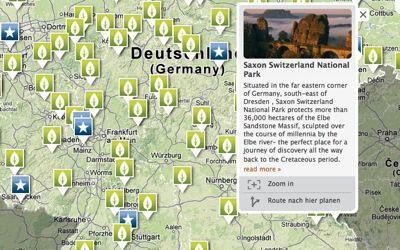It’s April and countless outdoor enthusiasts around the world are eyeing summer travel. For many, Germany is the target. For a first step in your planning process, explore the German National Tourist Board’s new interactive map of the country’s national parks and nature parks.
The country has 14 national parks, 14 Biosphere Reserves and 98 nature parks—all of them appearing as leaf symbols and explorable with a click on the neat new nature map. With your Germany summer travel in mind, click on the map symbols near your travel destinations and you get an English synopsis of many parks, or at the very least, a link to the park’s Website.
From there it’s easy to troll through Wikipedia’s page lists of the parks and jump to the parks dedicated Wiki page for a deeper look in English. And of course the German National Tourist Board’s major website is another resource for exploring individual parks and the attractions that surround them.
Internationally Known
Many people have heard of Berchtesgaden, the location of Adolf Hitler’s wartime aerie. Nearly 100-square miles of this spectacular area is a national park. The Wiki pages overview the parks but also offer external links, and in the case of Berchtesgaden, the link is to an English site with a pretty complete trail guide of the area.
Nature Parks
Germany's nature parks are an interesting wrinkle in Germany’s preservation programs. “They comprise about 25 percent of the total land area of Germany and are brought together under the Association of German Nature Parks,” says Wikipedia. “Parks that overlap into neighbouring countries are led by Europarc. The oldest is Luneburg Health Nature Park, whose core area was established in 1921.”
The country’s largest such park is Nature Park of the Central and Northern Black Forest, nearly 1,500 square miles, that sprawls along the country’s southwestern border.
Take A Visit
Saxon Switzerland National Park in the far eastern corner of Germany, south-east of Dresden, is a great example. The park protects the Elbe Sandstone Massif, sculpted over millennia by the Elbe river. The park's geology reaches back to the Cretaceous period. It’s a fascinating landscape, the only one of its kind in central Europe.
The park features sandstone cliffs, deeply carved valleys, table mountains and gorges—no wonder rock climbing is an excellent way to see Saxon Switzerland in all its glory. Visitors can also catch a glimpse of rare animals such as eagle owls, otters and dormice. The variety of habitats in this relatively small area creates a diverse fauna of ferns, lichen and mosses.
More leisurely ways to enjoy the breathtaking scenery include a trip to the Bastei rocks for stunning panoramic views across the Elbe.
Walks led by a national park ranger are available in the park, or you can take an exciting boat trip through the gorges. Recommended excursions include a river Elbe tour on one of the world's oldest paddle-steamers. You can also see the Lichtenhain waterfall on the old-fashioned Kirnitzsch valley tram.
Other attractions near the national park region, besides the national park’s main visitor centers, include massive Königstein Fortress. The magnificent city of Dresden is nearby with the hilltop castle of Neurathen.
Youth Travel
With national parks in some countries attracting fewer young people, Germany is in the middle of a strong youth travel trend that can’t help but direct attention to national and nature parks where outdoor activity is easily available. The country is marketing its "youth hotspots" with a special webpage.
In 2013, the German National Tourist Board is focusing on youth travel with the theme “Germany for young people – vibrant, fashionable, innovative.” “Young international travelers are a target group with considerable potential for tourism growth,” says Petra Hedorfer, chief executive officer of the GNTB. “From Europe alone, the source of the most overnight stays for Germany, almost ten million trips were made by young people aged between 15 and 29 in 2011.”
Pop around on the interactive park map and it’s easy to add a national park or nature park experience to your summer travel in Germany. And by the way, the "national park" map can be customized to call out virtually any other attraction you could want to visit in the country.




Comments
A handy tool, and a risk to the household travel budget :-) Thanks for sharing this!